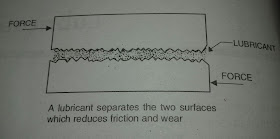Engine Lubrication:
An internal combustion engine would not run for even a few minutes if the moving parts were allowed to make metal-to-metal contact. The heat generated due to the tremendous amounts of friction would melt the metals, leading to the destruction of the engine. To prevent this, all moving parts ride on a thin film of oil that is pumped between all the moving parts of the engine. Once between the moving parts , the oil serves two purposes. One purpose is to lubricated the bearing surfaces. The other purpose is to cool the bearings by absorbing the friction-generated heat. The flow of oil to the moving parts is accomplished by the engine's internal lubricating system.
A great many parts in diesel engine operate one against the other. The friction thus caused generates heat resulting in abnormal expansion of the parts that ultimately would cause the parts to bind or seize one another. The friction between two surfaces is reduced by using a lubricant to separate the materials (in the picture). A flow of oil used for this purpose can also be used to carry away the excess heat from the metal parts.
Action of Lubricant:
 The main purposes thus served by lubrication are:
The main purposes thus served by lubrication are:
➤ To reduce wear
➤ To reduce friction
➤ To keep down the temperature of moving parts and thus prevent seizure
➤ Scoring of cylinders
➤ Excessive wear and burning of bearings
➤ Misfiring of cylinders
➤ Sticking of piston rings
➤ Engine deposits and sludge
➤ High consumption of fuel
Most of the engine mechanical breakdowns may be traced to failure of lubrication.


No comments:
Post a Comment